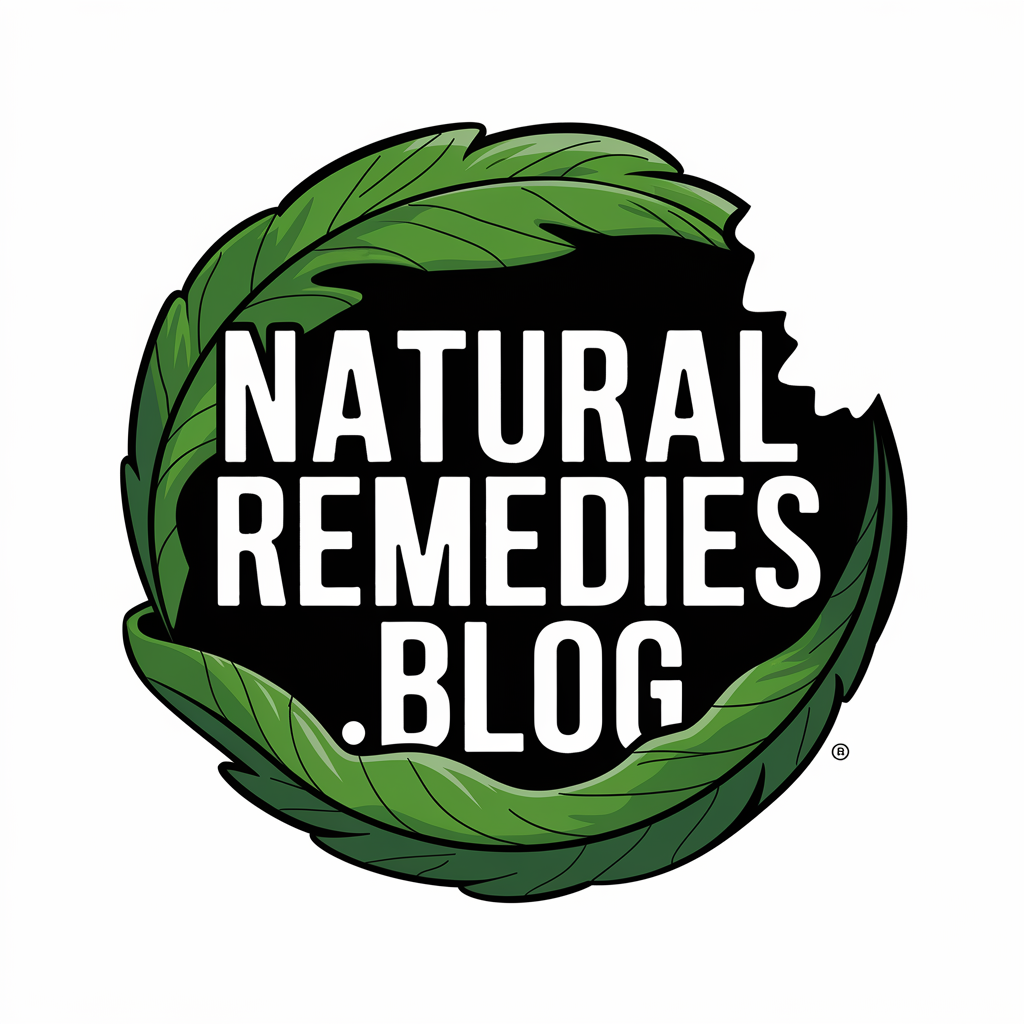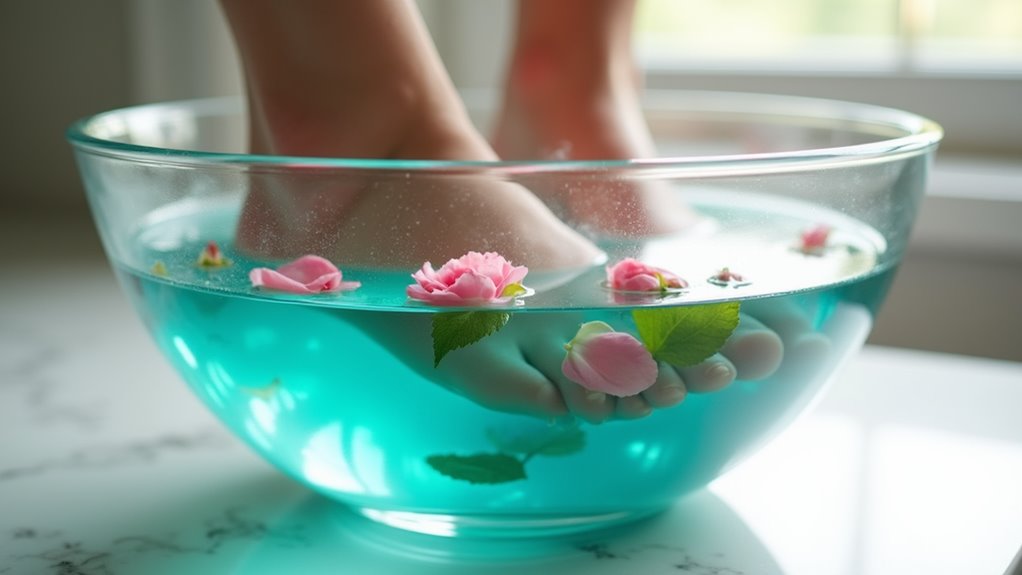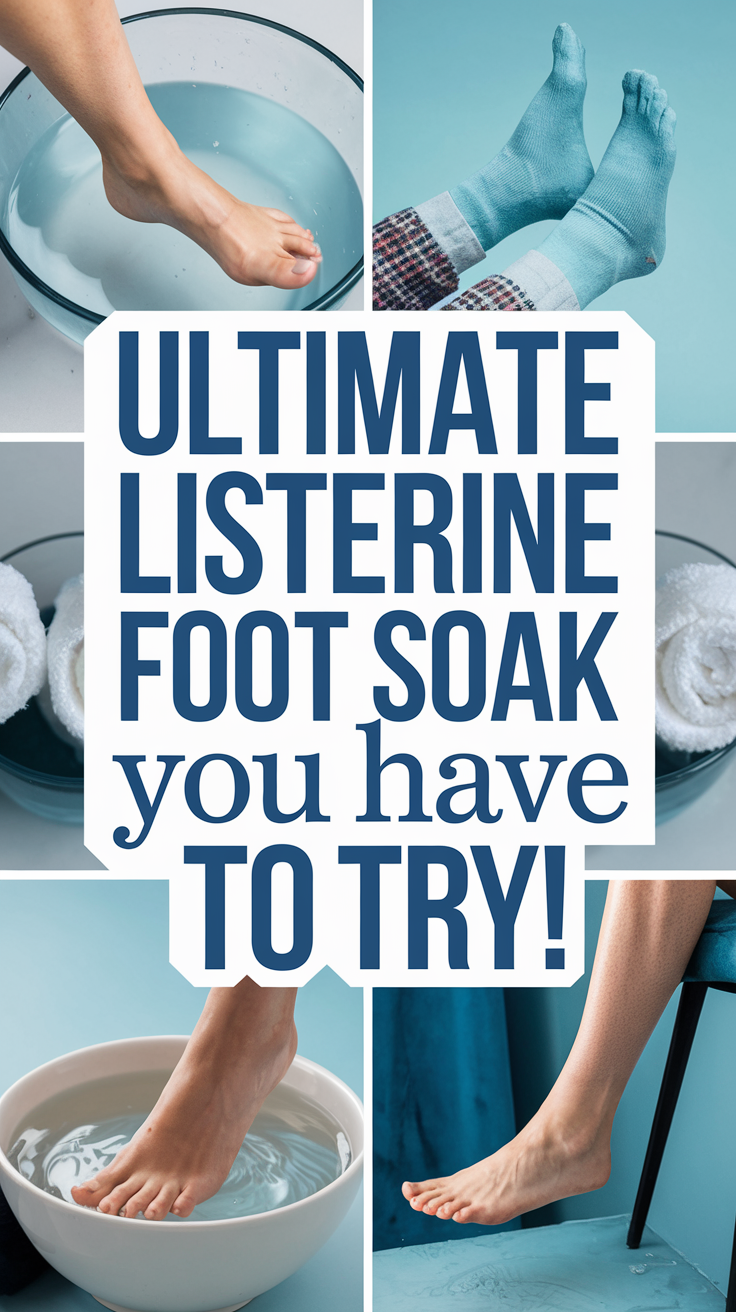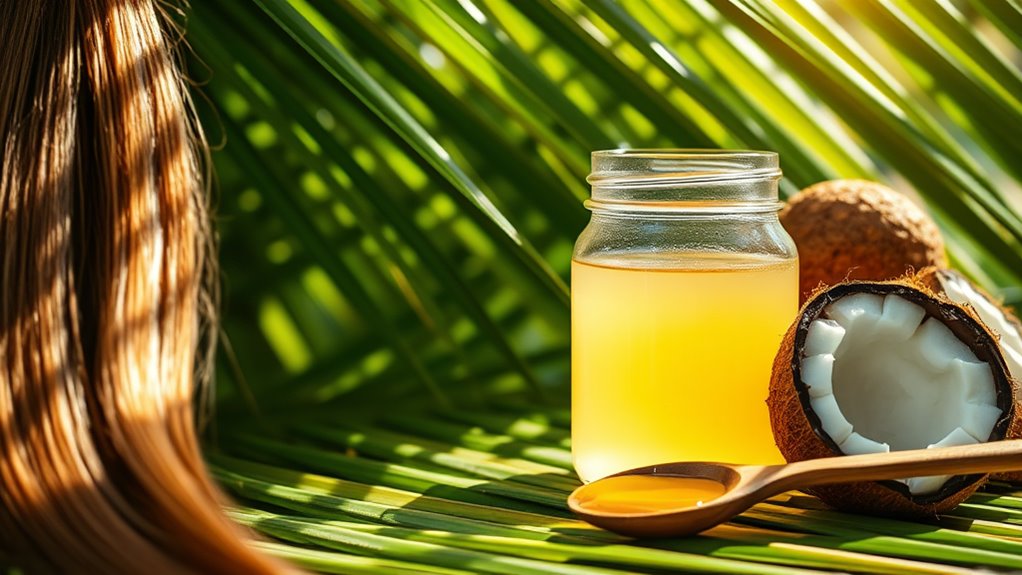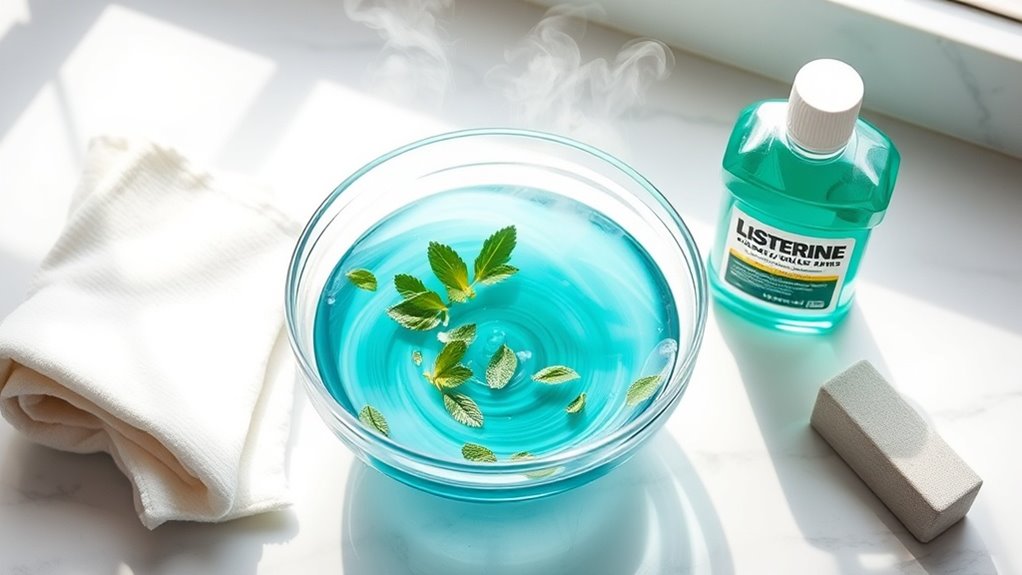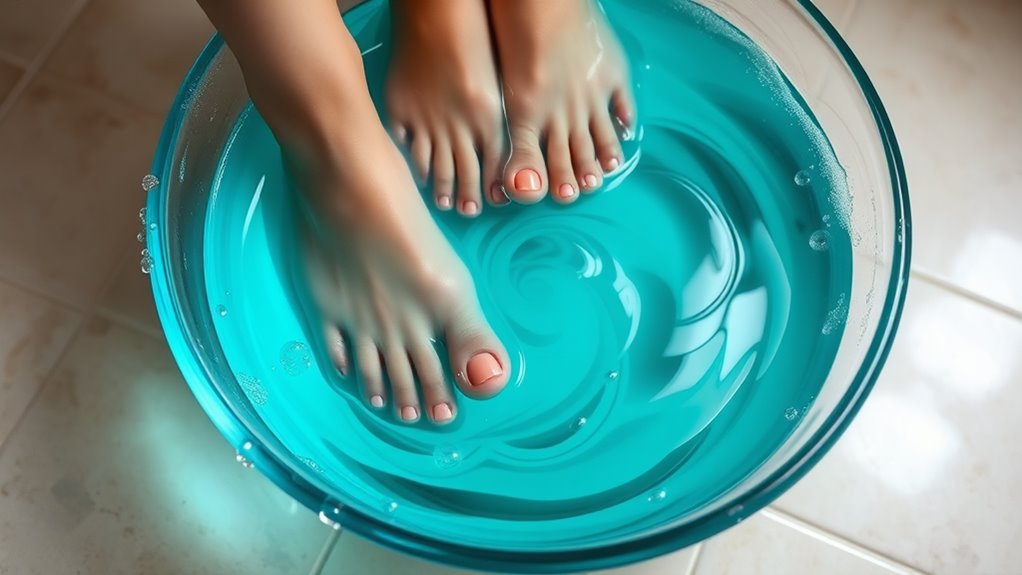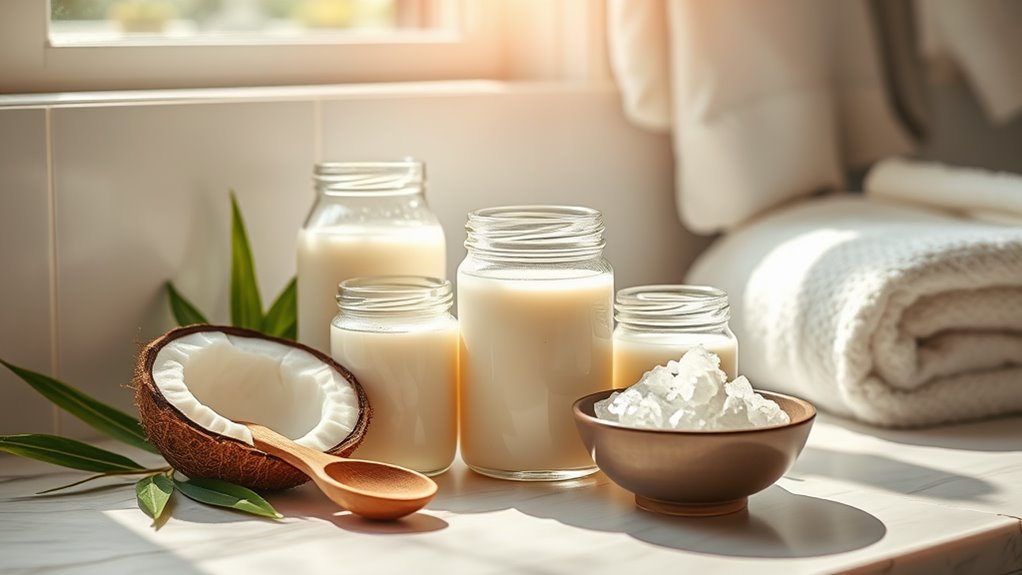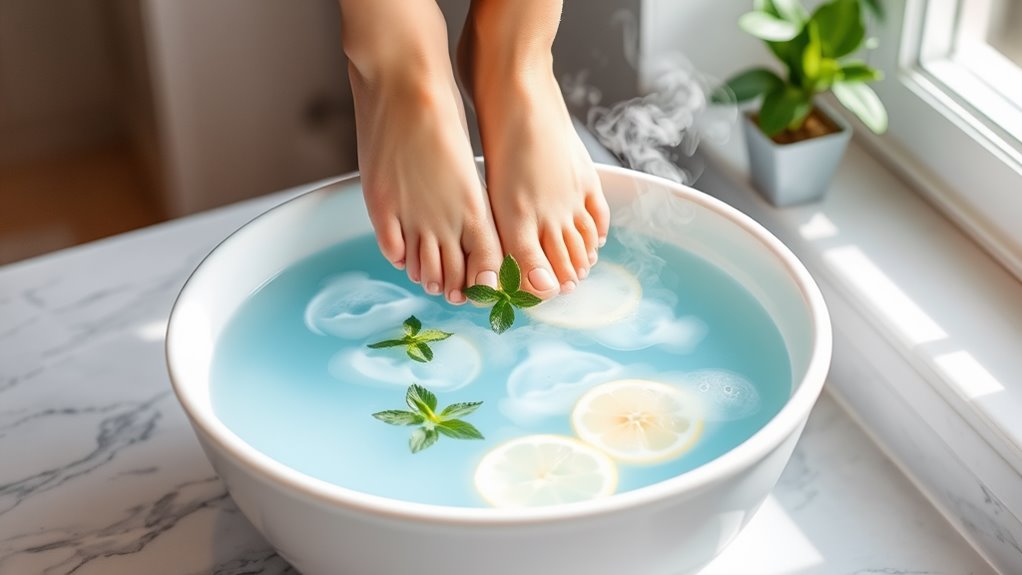Ultimate Listerine Foot Soak You Have to Try!
Transform your tired, achy feet into silky smoothness with this rejuvenating Listerine foot soak. Mix 1 cup of original Listerine, 1 cup of white vinegar, and 2 cups of warm water in a basin. Soak your feet for 45-60 minutes to soften rough skin, eliminate odors, and refresh your feet. The antimicrobial ingredients combat bacteria while essential oils penetrate deep to soften calluses. Discover how this affordable DIY treatment can revolutionize your foot care routine.
Key Takeaways
-
Mix 1 cup Listerine, 1 cup white vinegar, and 2 cups warm water in a basin for the perfect DIY foot treatment.
-
Soak feet for 45-60 minutes to soften rough skin, eliminate odor, and refresh tired feet naturally.
-
Add Epsom salt and essential oils like lavender or peppermint for enhanced relaxation and skin-softening benefits.
-
Follow with thorough drying and moisturizing cream while feet are damp, then wear clean cotton socks.
-
Repeat 2-3 times weekly for optimal results, including smoother skin, reduced calluses, and healthier-looking toenails.
What Is a Listerine Foot Soak
A Listerine foot soak is a DIY foot treatment that combines Listerine mouthwash with warm water to create a therapeutic bath for your feet.
You’ll join thousands of others who’ve discovered this popular home remedy that’s taken social media by storm. The treatment promises to soften rough skin, eliminate foot odor, and leave your feet feeling refreshed.
When you try a Listerine foot soak, you’re utilizing the antiseptic properties of the mouthwash’s active ingredients, including menthol, thymol, and eucalyptol.
These compounds work together to cleanse and rejuvenate your feet while providing a cooling sensation. The soak typically lasts 45-60 minutes, during which you can relax and let the solution work its magic on your tired feet.
The Science Behind Listerine for Foot Care
The science behind Listerine’s effectiveness for foot care lies in its powerful combination of antimicrobial ingredients. When you soak your feet in Listerine, active compounds like thymol, eucalyptol, and menthol work together to combat bacteria and fungi that cause foot odor and infections.
These essential oils penetrate your skin’s surface, creating an inhospitable environment for microorganisms while helping to soften calluses and dead skin.
The benzoic acid in Listerine acts as a natural exfoliant, while its high alcohol content helps dry out excessive moisture that can lead to athlete’s foot.
You’ll also benefit from the methyl salicylate, which provides a cooling sensation and mild pain relief. When combined with warm water, these ingredients enhance circulation to your feet, promoting better overall foot health.
Benefits of Using Listerine on Your Feet
Regular Listerine foot soaks offer multiple benefits that can transform your foot care routine. You’ll notice softer, smoother feet as the antiseptic properties help eliminate bacteria that cause foot odor and athlete’s foot.
The menthol in Listerine provides a cooling sensation that can soothe tired, achy feet after a long day. Your feet will feel refreshed as Listerine’s active ingredients help remove dead skin cells and reduce calluses.
The antimicrobial components work to prevent fungal infections while promoting healthier-looking toenails. You’ll also appreciate how this affordable solution keeps your feet feeling clean and rejuvenated, just like after a professional pedicure.
Many foot soak enthusiasts report reduced foot pain and improved circulation after incorporating Listerine into their self-care routine.
Essential Ingredients for the Perfect Foot Soak
Creating your perfect Listerine foot soak requires just a few simple ingredients that work together synergistically.
You’ll need 1 cup of original Listerine mouthwash, 1 cup of white vinegar, and 2 cups of warm water. These proportions guarantee the perfect balance of antiseptic and exfoliating properties.
For an enhanced experience, add 2-3 tablespoons of Epsom salt to help reduce inflammation and soften calluses.
You can also include a few drops of your favorite essential oil, like lavender or peppermint, to create a more spa-like atmosphere.
If you’re dealing with particularly tough calluses, add a quarter cup of baking soda to boost the soak’s softening power.
Remember to use a basin or tub that’s large enough to comfortably submerge your feet.
Step-by-Step Preparation Guide
Making your perfect Listerine foot soak starts with gathering all necessary ingredients and supplies in advance.
You’ll need a large basin or foot bath, warm water, 1 cup of Listerine, 1 cup of white vinegar, and 2 cups of warm water.
Fill your basin with warm water until it’s deep enough to cover your ankles.
Add the Listerine and vinegar to the water, then mix gently with your hand to combine all ingredients.
Test the water temperature with your elbow – it should feel comfortably warm, not hot.
If needed, adjust the temperature by adding more warm or cool water.
Place your basin in a comfortable spot where you can relax for the next 20-30 minutes, preferably near a chair or sofa.
Ideal Water Temperature and Timing
To achieve the best results from your Listerine foot soak, maintaining the right water temperature and timing is essential.
You’ll want to use warm water that’s comfortable to the touch, around 95-100°F (35-38°C). If the water’s too hot, you might damage your skin, and if it’s too cold, you won’t get the full therapeutic benefits.
For ideal results, soak your feet for 15-20 minutes. Don’t exceed 30 minutes, as prolonged exposure can lead to skin irritation. You can set a timer on your phone to keep track.
If you’re treating fungal infections or particularly rough skin, try soaking three times per week. For general maintenance and relaxation, once or twice weekly is perfect.
Remember to check the water temperature periodically, as it will gradually cool during your soak.
Best Time of Day for Your Foot Soak
While timing your soak length matters, choosing the right hour of day can maximize your foot soak benefits.
Evening soaks, particularly before bedtime, are ideal as they help you wind down and prepare for restful sleep. You’ll also give your feet time to fully dry before putting on socks or shoes.
If you’re an athlete or spend long hours standing, schedule your foot soak right after work or intense physical activity. This timing helps reduce inflammation and provides immediate relief when you need it most.
For those with fungal concerns, morning soaks can be beneficial since you’ll start your day with clean, refreshed feet. Just make sure you have enough time to thoroughly dry your feet before putting on footwear.
Common Foot Issues This Soak Addresses
Listerine foot soaks effectively address several common foot ailments that many people face. If you’re dealing with stubborn athlete’s foot, this antiseptic solution helps combat the fungal infection while reducing itching and burning.
You’ll find relief from foot odor thanks to Listerine’s powerful antibacterial properties that eliminate odor-causing bacteria. The soak can also help soften calluses and remove dead skin, leaving your feet smoother and more presentable.
If you’re experiencing mild foot pain or inflammation, the menthol in Listerine provides a cooling sensation that can be quite soothing. For those struggling with toenail fungus, regular soaks may help prevent its spread and support healing.
Many users report that their feet feel refreshed and revitalized after incorporating this treatment into their foot care routine.
Safety Precautions and Considerations
Before trying a Listerine foot soak, you should be aware of several important safety considerations.
Don’t use this treatment if you have open wounds, cuts, or infections on your feet. If you’re diabetic, consult your doctor first, as foot soaks can increase infection risks.
Test a small area of your skin first to check for allergic reactions. If you experience burning, redness, or irritation, discontinue use immediately.
Limit your soaking time to 30 minutes, as extended exposure can dry out your skin. Don’t reuse the solution – prepare fresh mixture each time.
Keep the temperature comfortably warm, not hot, to prevent burns. If you’re pregnant or have circulation issues, check with your healthcare provider before starting this routine.
Always dry your feet thoroughly afterward to prevent fungal growth.
Adding Essential Oils to Your Soak
Adding a few drops of aromatic oils to your foot soak can enhance its therapeutic benefits beyond the basic Listerine mixture.
Tea tree oil adds extra antifungal properties, while lavender oil promotes relaxation and skin healing. You’ll love how peppermint oil creates a revitalizing sensation and helps with foot odor.
For the perfect blend, add 3-4 drops of your chosen essential oil to your Listerine foot soak.
If you’re dealing with stubborn athlete’s foot, combine tea tree and eucalyptus oils for a powerful antifungal boost. For tired, achy feet, try a combination of lavender and chamomile oils to soothe your muscles.
Remember to always use high-quality essential oils and do a patch test first to verify you don’t have any skin sensitivities.
Post-Soak Foot Care Routine
Three essential steps follow your Listerine foot soak to maximize its benefits.
First, gently pat your feet dry with a clean towel, making sure to dry between your toes to prevent fungal growth. Don’t skip this vital step – proper drying sets you up for success.
Next, apply your favorite moisturizing foot cream while your feet are still slightly damp. Work the cream into your heels, balls of feet, and any callused areas. You’ll lock in the softening effects of your soak this way.
Finally, put on a pair of clean cotton socks to seal in moisture and protect your freshly treated feet. Keep them on for at least an hour to allow the moisturizer to fully absorb.
You’ll love how soft and refreshed your feet feel.
How Often to Do the Treatment
Regular Listerine foot soaks can be done 2-3 times per week for ideal results.
You’ll notice the best benefits when you maintain a consistent schedule, just like thousands of others who’ve made this treatment part of their self-care routine.
If you’re dealing with specific foot issues like athlete’s foot or excessive odor, you might want to increase the frequency to once daily until symptoms improve.
However, don’t exceed this recommendation, as overuse could dry out your feet.
For maintenance, once you’ve achieved your desired results, you can reduce the treatments to once per week.
Remember to listen to your feet – if you notice any irritation or sensitivity, space out your treatments more.
You’ll soon find the perfect rhythm that works for your needs.
Signs of Positive Results
Positive changes from Listerine foot soaks typically appear within the first few treatments.
You’ll notice your feet feeling softer and smoother after each session, with dead skin becoming easier to remove during your next pedicure.
Watch for these encouraging signs that your foot soak is working: reduced foot odor, diminished appearance of athlete’s foot symptoms, and overall improved foot hygiene.
Your toenails may begin to look clearer and healthier, especially if you’ve been dealing with mild fungal issues. The skin between your toes will feel drier and less prone to irritation.
You’re on the right track when your feet stop feeling itchy and uncomfortable.
Many users report their feet feeling more refreshed and energized, making it easier to stay active throughout the day.
Maintaining Foot Health Between Soaks
While Listerine foot soaks can provide excellent results, maintaining proper foot care between treatments is essential for ideal benefits.
You’ll want to keep your feet clean and dry, especially between your toes, to prevent fungal growth. Don’t forget to moisturize daily with a quality foot cream to prevent cracking and dryness.
Wear breathable socks and properly fitting shoes to reduce sweating and pressure points.
When you’re at home, let your feet breathe by going barefoot occasionally.
You’ll also benefit from regular nail trimming and gentle exfoliation to prevent dead skin buildup.
If you’re active, make sure to change your socks after exercising, and consider using an antifungal powder to keep your feet fresh and protected between soaks.
Combining With Other Foot Treatments
Listerine foot soaks work well alongside many other foot treatments to enhance their effectiveness. You can pair your soak with a pumice stone to remove dead skin or follow up with moisturizer to lock in softness.
Add Epsom salts to your Listerine soak to help reduce inflammation and soothe tired muscles.
For extra pampering, try combining your foot soak with essential oils like lavender or tea tree oil, which offer additional antibacterial properties.
You’ll love following your soak with a foot massage using coconut oil or shea butter. If you’re dealing with stubborn calluses, apply a urea-based cream after your soak when your skin is most receptive to treatment.
Remember to space out intensive treatments to avoid irritating your feet.
Storing Your Foot Soak Solution
Although it’s tempting to save your foot soak mixture for future use, you shouldn’t store premixed Listerine solutions for more than 24 hours. The antiseptic properties can become less effective over time, and bacteria may develop in the standing water.
If you’re planning multiple foot soaks throughout the week, mix fresh solutions each time. You’ll get better results by storing your Listerine, vinegar, and other ingredients separately in their original containers. Keep them in a cool, dark place away from direct sunlight.
For the most hygienic practice, clean your soaking container thoroughly after each use and let it dry completely. This way, you’ll maintain the full benefits of your foot soak while ensuring a safe, bacteria-free experience every time you treat yourself.
Troubleshooting Common Problems
Common issues can arise during your Listerine foot soak routine, but most have simple solutions.
If your skin feels irritated, dilute the solution with more warm water or reduce soaking time to 15 minutes.
When the mixture isn’t effectively softening calluses, try increasing the Listerine ratio slightly or soaking for an extra 5 minutes.
Notice discoloration on your feet? Don’t worry – it’s temporary and will fade within 24 hours.
If you’re not seeing results after several sessions, make sure your water temperature is comfortably warm and you’re using the original antiseptic Listerine formula.
For stubborn foot odor that persists, add 1/2 cup of baking soda to your soak.
If any irritation continues or worsens, discontinue use and consult your healthcare provider.
Alternative Ingredients and Variations
While traditional Listerine foot soaks work well, you can customize your treatment with several effective alternatives.
Try adding a cup of Epsom salt to boost magnesium absorption and reduce inflammation. For extra moisture, mix in two tablespoons of coconut oil or olive oil. Tea tree oil offers additional antifungal benefits – just add 5-10 drops to your soak.
If you’re sensitive to Listerine, consider using apple cider vinegar instead. Mix one part vinegar with two parts warm water for similar antibacterial properties. White vinegar works too, though it’s slightly less potent.
For a spa-like experience, add fresh mint leaves or lavender essential oil to your foot bath. These natural additions not only smell wonderful but also provide therapeutic benefits.
Frequently Asked Questions
Can I Use Generic Mouthwash Instead of Listerine for the Foot Soak?
You’ll want to stick with Listerine since it contains specific active ingredients that work best for feet. Generic versions might not have the same antiseptic properties you’re looking for.
Will Listerine Foot Soaks Stain My Feet or Toenails?
You won’t have to worry about staining since Listerine won’t discolor your feet or toenails. The blue color rinses right off, and you’ll be left with fresh, clean feet.
Does the Color of Listerine Affect the Effectiveness of the Foot Soak?
You’ll get the same benefits from any Listerine color since they all contain similar active ingredients. The dye won’t impact effectiveness, so choose whichever shade you’re most comfortable using.
Can I Reuse the Listerine Foot Soak Solution Multiple Times?
You shouldn’t reuse the foot soak solution since it won’t be as effective and could harbor bacteria. For the best results and your health, mix a fresh solution each time.
Should I Avoid Pedicures Before or After Doing a Listerine Foot Soak?
You’ll want to avoid pedicures 24-48 hours before or after your Listerine soak. This gives your feet time to balance out and prevents any potential skin sensitivity issues.
